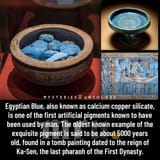>>17935880
>Egyptian blue, also known as calcium copper silicate (CaCuSi4O10 or CaOCuO(SiO2) (calcium copper tetrasilicate)) or cuprorivaite, is a pigment that was used in ancient Egypt for thousands of years. It is considered to be the first synthetic pigment
>Egyptian blue is produced from a mixture of silica, lime, copper, and an alkali. Its color is due to a calcium-copper tetrasilicate CaCuSi4O10 of the same composition as the naturally occurring mineral cuprorivaite. It was first synthesized in Egypt during the Fourth Dynasty and used extensively until the end of the Roman period in Europe, after which its use declined significantly
>The ancient Egyptians held the color blue in very high regard and were eager to present it on many media and in a variety of forms. They also desired to imitate the semiprecious stones turquoise and lapis lazuli, which were valued for their rarity and stark blue color. Use of naturally occurring minerals such as azurite to acquire this blue was impractical, as these minerals were rare and difficult to work. Therefore, to have access to the large quantities of blue color to meet demand, the Egyptians needed to manufacture the pigment themselves
>The ancient Egyptian word wꜣḏ signifies blue, blue-green, and green
>The term for it in the Egyptian language is ḫsbḏ-ỉrjt (khesbedj irtiu), which referred to artificial lapis lazuli (ḫsbḏ). It was used in antiquity as a blue pigment to color a variety of different media such as stone, wood, plaster, papyrus, and canvas, and in the production of numerous objects, including cylinder seals, beads, scarabs, inlays, pots, and statuettes. Sometimes, it is referred to in Egyptological literature as blue frit. Some have argued that this is an erroneous term that should be reserved for use to describe the initial phase of glass or glaze production, while others argue that Egyptian blue is a frit in both the fine and coarse form since it is a product of solid state reaction
